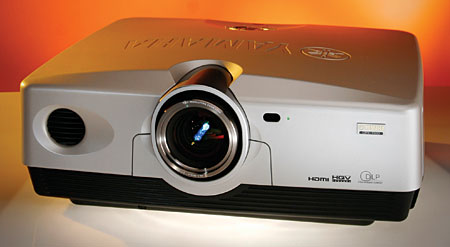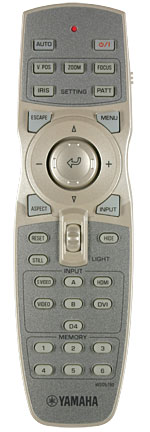Yamaha DPX-1300 DLP Projector
Like any type of product, toward the end of its run, you tend to find the most advanced, best examples. Years of development culminate in the last few models in a category. Take, for example, the few high-end CRTs on the market. They're some of the best. DVD players are currently cheaper and, in many cases, better than models we saw just a few years ago. Then there's the high-end 720p DLP projector. With 1080p here in the form of Sony's VPL-VW100, and 1080p DLP on the horizon, the real question is, should you spend the money on a high-end projector that is only 720p? Well, I can't say for sure across the board, but, in this case, I can say most assuredly, yes.

You Serious?
The DPX-1300 embodies nearly everything that is good about high-end DLP projectors. It has an excellent contrast ratio (3,400:1), nearly perfect color points, and impressively low noise. More importantly, the DPX-1300 has truly excellent scaling. This is what puts it in contention for your dollar against the higher-resolution VPL-VW100. But I'm getting ahead of myself.
Like its predecessors, the Yamaha DPX-1300 is a single-chip DLP. Its case is nearly identical to those of its younger siblings. That's fine, because it's attractive and commendably quiet. The same is true of the remote. It is partially backlit, gives you direct input access, and is pretty much everything a remote should be. I can also say the same of the menus. While they lack flash, they are easy to navigate and have lots of adjustments. New on the DPX-1300 is the inclusion of a DVI input in addition to the single HDMI input found on the previous model.
How to Do Color Right
It is not difficult to get accurate color points; it is often just a design decision not to. In fact, on a show floor, inaccurate color points will draw your eye first. This is probably why the DPX-1300, out of the box, has slightly oversaturated color points. When your competition is the ridiculously oversaturated VPL-VW100, slightly oversaturated colors are an obvious way to maintain competitiveness on the unforgiving showroom floor. Where the DPX-1300 simply owns the VPL- VW100 is that each color point is widely and easily adjustable. In fact, after adjustment, I got the green and red color points so close to perfect that any error was within the measurement tolerances of our Photo Research PR-650. Blue was still a little off, but just barely. This, and an excellent color decoder, made for a fantastically realistic and pleasing image. Whereas the VPL-VW100 was overly vibrant, the DPX-1300 just looked right. It was downright relaxing to watch.
Punchy
While its full-on/full-off contrast ratio of 3,400:1 isn't the most amazing we've measured, it is still well above average. Strangely, it is a step down from the Yamaha DPX-1100 I measured for the March 2005 issue. I checked with a colleague who is also reviewing the DPX-1300, and he found the same thing. ANSI contrast is up slightly, though, at 527:1. This is notable, as it is more than twice the VPL-VW100's ANSI and the highest we've ever measured in a projector, just inching out the Sharp XV-Z12000 MARK II from the March 2006 issue. In other words, the onscreen image is punchy and has a lot of depth. The black level is an excellent 0.002 foot-lamberts in its lowest mode.
The New Sheriff
A few years ago, Faroudja was the "it" name in deinterlacing, and, by extension (confusion?), scaling, as well. Then, seemingly without warning, Silicon Optix hit the scene. Very quickly, they established themselves at the forefront of the scaling world (it's admittedly a small world) and left Faroudja in the dust. Their HQV processing takes all the goodness that was in the pro-level, $50,000 Teranex über processor and somehow squeezes it all into one chip. From the times I've seen it at shows, it's looked impressive, but this was my first chance to run it through its paces. (Incidentally, we have another product with an HQV chip in it in this issue's Hook Me Up on page 37.) It also gave me the chance to see how the Silicon Optix Realta HQV processor would fare on their own test disc. Not surprisingly, it picked up the 3:2 sequence quickly. The waving flag was extremely clean, with almost no noticeable jagged edges. One test, a spinning white bar, also tests for jagged edges. On this test, the Realta HQV was about the best I've seen, although it wasn't perfect. (I haven't seen any that are perfect.) Jagged edges were only noticeable when the bar was nearly horizontal. For comparison, the DVD player in the Cambridge SoundWorks HTIB reviewed on page 78 had jagged edges pretty much throughout the bar's rotation.
To be sure the synthetic tests were indicative of real video, I put in the old standbys. The end of chapter 12 of Gladiator looked excellent—as good as I've seen. The rooftops in the flyover of ancient Rome were impressively clean, with nearly no jagged edges on any diagonal.
Then there's chapter 2 of The Fifth Element. In this scene, there are lots of close-ups of faces and rocks. A good scaler will bring out hidden detail. The trick is to bring out that detail but not accentuate or add any noise to the image. While I have seen scalers that create more apparent detail than the HQV, I've never seen one that offers this level of detail with such low noise. In fact, it was quite some time into my testing before I noticed how clean the image was. Solid colors were actually solid, with no artifacts or extraneous noise. It is so clean that you don't even notice that it is clean. You just take it for granted. It's easy to get rid of noise in an image, but to get rid of noise and make the image more detailed is a commendable feat. Scale me impressed.
 Everything Else
Everything Else
Transitions from light to dark, visible with a gray ramp and actual video material, were very smooth. Shadow detail was excellent. Master and Commander, although it never looks good on any digital display, was very watchable. The opening of the D-VHS of Digital Video Essentials has one shot where the space shuttle is in mid-flight, surrounded by a bright-blue, and typically noisy, sky. On the DPX-1300, the image still had some of the inherent noise of the image, but it wasn't nearly as severe as I've seen it on other displays. Detail was, of course, superb. With an HTPC outputting 720p, the image was sharp and free of noise. Too often, text is nearly impossible to read with this kind of setup, but here it was perfect.
On the Other Hand
While it would be easy to dismiss the DPX-1300 because of its 720p resolution, just look at it this way: With DVDs, the DPX-1300 will likely look shaper, thanks to its better scaling. With 720p, the DPX-1300 will arguably look better, due to its low noise and better color. Even with 1080i, a 1080p projector may look more detailed, but that may be the only way it looks better. The DPX-1300 would still have more accurate color and an excellent contrast ratio.
So, where does that leave us? Well, to be sure, the DPX-1300 is the pinnacle of single-chip 720p DLP performance. It has nearly perfect color, an excellent black level and contrast ratio, and exceptional scaling. But is that enough? At $12,496, it is 25 percent more expensive than the VPL-VW100, which will have a much easier job selling itself with the Sony name and that apparently magic number "1080p" attached. How do you sell scaling and accurate color points in a world that only cares about resolution and contrast ratio? For those videophiles out there who can appreciate a projector that does right all the things the Sony does wrong, are looking to get a projector right now, and have the cash, the DPX-1300 is without a doubt your projector. Regardless of resolution, it's one of the best-looking and most accurate displays you can buy.
Highlights
• Nearly perfect color
• Uses Silicon Optix Realta HQV chip
• Good luck finding better scaling




























































